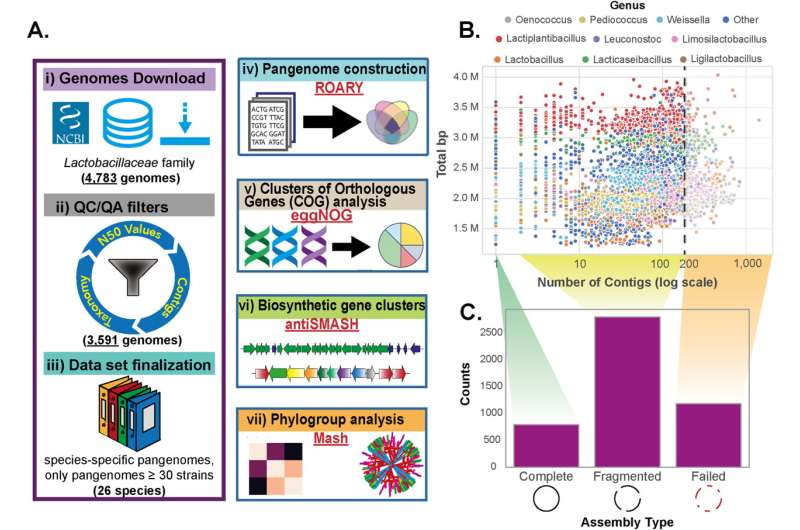This article has been reviewed according to Science X's editorial process and policies. Editors have highlighted the following attributes while ensuring the content's credibility:
fact-checked
proofread
Comprehensive pan-genome analysis of lactic acid bacteria unveils new avenues for food industry and health care

A team of international researchers has published the first comprehensive comparative pan-genome analysis of lactic acid bacteria (LAB), a family of microorganisms essential to natural ecosystems and the food industry. Published in Food Microbiology, the study was carried out by scientists from the Novo Nordisk Foundation Center for Biosustainability (DTU Biosustain) and the University of California, San Diego.
The new study represents a crucial leap in understanding the genetic capabilities of 26 LAB species, in the first of it's kind family-wide pangenome analysis. By analyzing over 2,400 publicly available genomes of high quality, the researchers successfully mapped the functional genetic capabilities, metabolic pathways, and biosynthetic gene clusters of individual strains across 26 species in the Lactobacillaceae family.
Researchers developed a novel integrated workflow for large-scale pangenome analysis that includes important steps of data curation, taxonomic definitions, phylogroup identification, pangenome reconstruction, functional annotations and genome mining. This advanced computational analysis resulted in better understanding of functional differences across different LAB species as compared to prior efforts focused on individual species or metagenome studies.
"In mapping the genetic landscape of LAB, we have cracked open the door to a treasure trove of novel possibilities represented by phylogenetic groups and individual strains for future biotechnological applications," says Postdoc Omkar Satyavan Mohite from DTU Biosustain who is one of the lead authors of the study.
Can drive advancement in the food industry and health care
The outcomes of this research are not confined to data science investigation of microbes; they have real-world applications. "We've laid the groundwork for everything from species identification and functional studies to phylogenetic research and biotechnological innovations. This work can drive advancements in various sectors, including the food industry, health care, and environmental sciences," says Akanksha Rajput, a Postdoctoral Researcher at UCSD and also one of the lead authors of the study.
This research is especially relevant for experts and investigators across academic, industrial, medical, and environmental domains, all of whom can utilize these data driven insights to prioritizing strains of required genetic background.
According to the researchers, future work will use pan-genomic characteristics as a key tool for delving deeper into bacterial evolution, metabolic pathways, or sequence level variation. The integrated pangenome analysis workflow harvested here could be crucial platform to further investigate other microbial groups of industrial relevance.
The corresponding author of the study is Professor Bernhard O. Palsson. The study was led by Akanksha Rajput (Postdoctoral Researcher at UCSD), Siddarth Chauhan (Ph.D. student at UCSD), and Omkar S. Mohite (Postdoctoral Researcher at DTU Biosustain). Collaboration included teams from DTU Biosustain's Microbial Foods, the Reconstruction Team, and Genome Analytics.
More information: Akanksha Rajput et al, Pangenome analysis reveals the genetic basis for taxonomic classification of the Lactobacillaceae family, Food Microbiology (2023). DOI: 10.1016/j.fm.2023.104334
Provided by Danmarks Tekniske Universitet The Novo Nordisk Foundation Center for Biosustainability



















